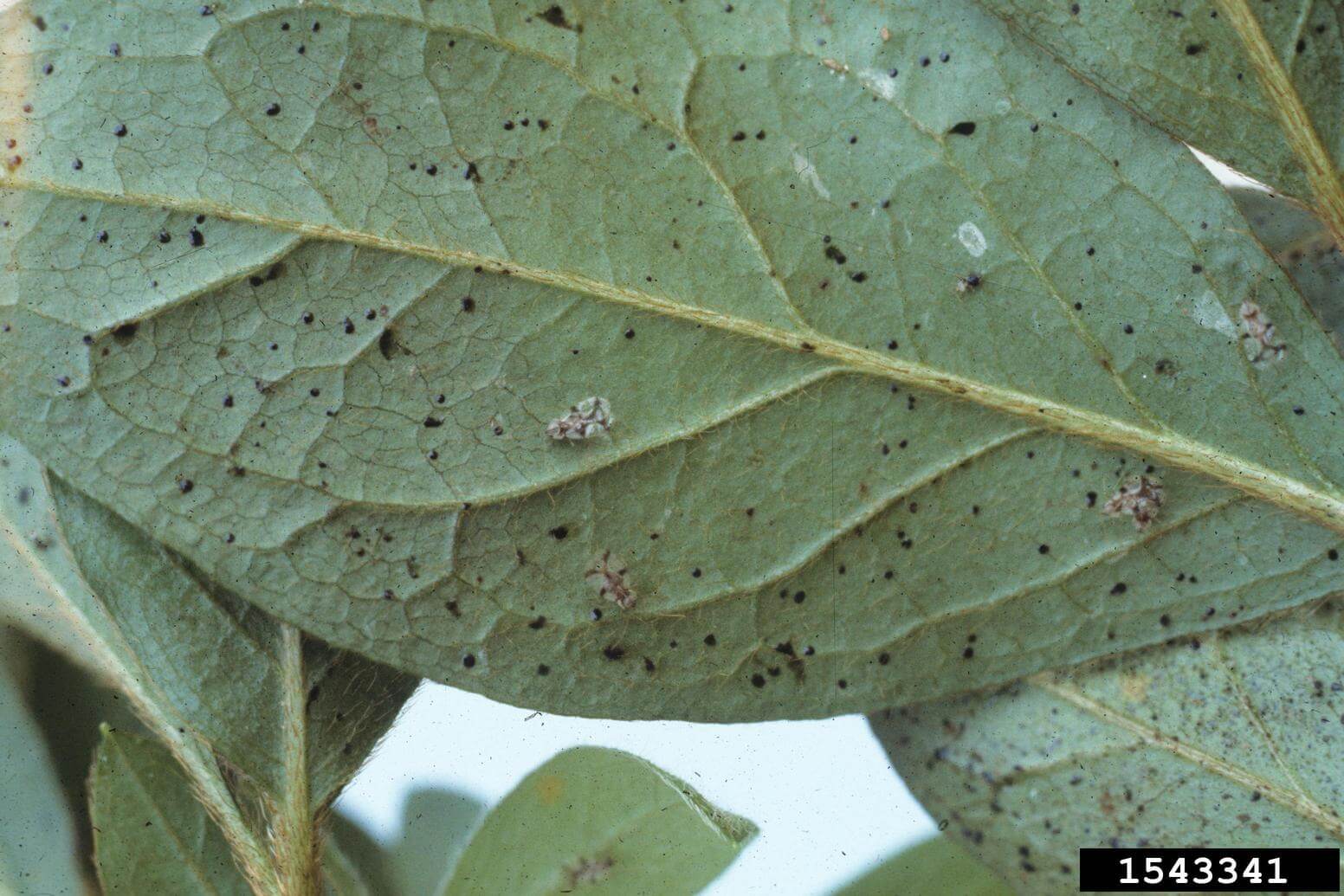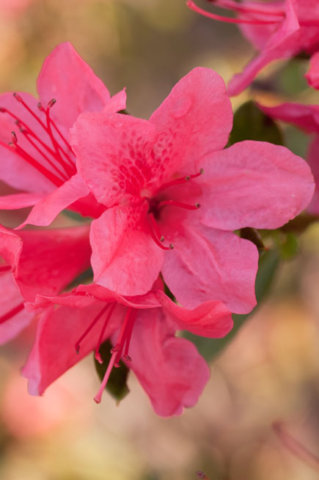
There are several things you can do to manage lace bugs. Keeping your plants well watered is a key strategy. Photo: Jim Baker, North Carolina State University, Bugwood.org.
We are seeing lace bugs on shrubs in some of our clients’ landscapes. Usually the main difference between having a few lacebugs or having an epidemic? Giving your plants enough water.
We mainly see lace bugs on rhododendrons and azaleas and occasionally on other broadleaf evergreen shrubs. Lace bugs are a problem in the Pacific Northwest because of our mild climate. Cold weather rarely kills off lace bugs in any of their life stages.
How to tell if you have lace bugs
When lace bugs feed, they cause yellow pinpoints or stippling in the leaves. Heavily damaged leaves appear yellow. Lace bugs suck the life out of leaf tissue and may eventually kill your shrubs.
Lace bugs are about 1/8 inch long. They have clear wings sporting dark blotches in a lacy pattern. Eggs appear as black or brown dots on the underside of leaves. Nymphs look like tiny clear, yellow or black spiky things. Females lay eggs partly into the plant tissue, hidden under poop. This makes it tough to treat lace bugs with pesticides.
There are several species of lace bugs, according to an article in the Madison Park Times. The azalea lace bug attacks azaleas, rhododendrons and mountain laurel (Stephanitis pyrioides). Other species include the rhododendron lacebug (Stephanitis rhododendri), andromeda lace bug (Stephanitis takeayi), hawthorn lace bug (Corythucha cydoniae), grass lace bug (Leptodictya plana) and avocado lace bug (Pseudacysta perseae). There are also lace bugs that feed on alder, ash, coyote brush, birch, ceanothus, photinia, poplar, sycamore and willow.
The azalea lace bug is more difficult to control than the rhododendron lace bug. The rhododendron lace bug only has one generation per year, so only one treatment is necessary. Unfortunately, in 2008 the azalea lace bug moved into Washington. This insect has multiple generations per year, so it is much more damaging and harder to manage. Lace bugs thrive in sunny locations, since their natural enemies avoid these places.
What you can do to manage lace bugs
Our recent trend toward hot, dry summers has exacerbated problems with lace bugs. “Studies have shown that drought-stressed plants are much more susceptible to lace-bug attack,” said Ciscoe Morris in the Seattle Times,
Keep your plants well watered
Water slowly and deeply to reach the entire root zone. Watch our video on how to water to make your plants strong and healthy. And see our list of watering resources below.
Many insects only target weak plants. When a plant goes into any kind of stress, stressed plants often emit distress signals that many damaging insects pick up on. Drought-stressed plants are prime targets for lace bugs.
According to the American Rhododendron Society, rhododendrons and azaleas are very shallow rooted (one to two feet deep). The root zone may dry out during the hot summer season, while plants with deeper roots may show no signs of drought stress.
The Society says that rhododendrons should be well watered during the hot months. This is especially important during the first year after planting when the roots have not yet gotten out of the original root ball and into the surrounding soil.
It is important when watering all plants to let the soil partially dry out before watering again. Rhododendrons and azaleas ideally grow in damp, never soggy soil. Read more about watering rhododendrons from the American Rhododendron Society and SF Gate Home Guides.
Look for and destroy eggs and nymphs in spring
You could use a nontoxic spray such as horticultural oil, insecticidal soap and neem-based products. Coat the leaves well, including on the underside. Repeat regularly.
According to Oregon State University, insecticidal soaps and oils must directly contact the insects to control them. They work best on newly hatched nymphs but can have 80-90% control if used correctly. Horticultural oil can also smother the egg stage.
Neem-based products act as anti-feedants, insect growth regulators, and repellants. “Research from New Jersey has shown a 50% reduction of azalea lace bugs after a neem application,” according to OSU. Early season control is very important with tools such as insecticidal soaps, oils and neem.
We don’t recommend using chemical insecticides. They kill important pollinators and beneficial insects that kill other pests.
Call us: we can help you manage lace bugs
We use M-Pede to reduce populations. This product is made from a fatty acid. It’s safe and has limited effects on beneficial insects. We start monitoring for lace bugs in our clients’ landscapes in spring because nymphs are easier to kill than adults. Contact us if you are interested in an application.
Our natural tree and shrub care program can also help. We use compost tea, micronutrients and other products to build the health of soil and plants. A healthy plant will better resist insects and diseases.
Encourage beneficial insects
A number of insects eat lace bugs. This includes spiders, green lacewings, earwigs, lady beetles, soldier beetles, assassin bugs, pirate bugs, plant bugs, tree crickets and mites. Research has shown that releasing lacewings among target plants reduces damage from lace bugs.
You can attract green lacewings and other beneficial insects by planting low-growing plants. Options could include ornamental grasses, heather, salal, epimedium and other evergreen perennials. Flowering plants like dill, dandelion, fennel, cosmos and yarrow also attract beneficial insects. Maintain a wild area in your garden for a natural habitat that will protect and grow populations of beneficial insects.
Apply mulch or compost to beds
Mulch keeps moisture in the soil and prevents shrubs from drying out. It is best to apply mulch in early spring when the soil is cool and damp. You can still add mulch now if you water deeply before applying mulch. Use a thick layer of mulch to reduce both water needs and weeds. Remember to keep several inches of space between the mulch and the plant stem.
Don’t over-fertilize
According to the American Rhododendron Society, in fertile soils rhododendrons and azaleas do not need to be fertilized. in less-fertile soils you can apply a complete fertilizer designed for acid-loving plants in late winter or early spring. But use only the amounts recommended for rhododendrons and azaleas.
These plants do not need as much fertilizer as other plants. Excessive fertilization may damage roots and leaves. It may even kill some rhododendron varieties.
Move azaleas and rhododendrons to shadier areas if possible
Most rhodies and azaleas prefer shady conditions, so sun stresses the plant. Plants growing in full sun are nearly twice as likely to get infested as those growing in partial shade. It also dries them out more quickly than would shady conditions.
Consider replacing the plant
Decide how important your plant is to you and how much you want to do to manage the problem. You may choose to replace problem plants with something that takes less work to look good and stay healthy.
Resistant plants

Choosing a resistant plant will make it easier to manage lace bugs. ‘Autumn Cheer’ is a resistant azalea.
According to Oregon State University, some azaleas show resistance to azalea lace bug. A horticultural research study found these Encore Azalea cultivars to be resistant: Autumn Amethyst, Autumn Twist, Autumn Royalty, Autumn Sangria, Autumn Cheer, and Autumn Rouge. Cultivars showing moderate resistance were Autumn Embers, Autumn Bravo, Autumn Starlite, Autumn Ruby, and Autumn Princess.
Another study from Virginia Beach Experiment Center shows additional varieties with resistance.
- Indica alba – white
- Flame Creeper- white
- Delaware Valley White – white
- Rosebud* – pink
- Cooperman – red
- Hahn’s Red – red
- Boldface – lavender
- Mrs. G.G. Gerbing – white
- Dream – white
- Salmon Beauty – pink
- Hinocrimson* – red
Resistant pieris varieties include Pieris phillyreifolia and P. japonica ‘Variegata.’
If you would prefer another type of shade-tolerant flowering shrub, try native Oregon grape, red flowering currant or exotic kalmia, hydrangea, osmanthus or daphne.
More info on managing lace bugs
Azalea lace bugs are even peskier than the familiar rhododendron ones, Ciscoe Morris, Seattle Times.
Azalea Lace Bug: Biology and management in commercial nurseries and landscapes, Oregon State University.
Azalea lace bug, Oregon Metro.
Azaleas, rhododendrons face severe threat from lace bugs, The Oregonian.
Bugs & blights: lace bugs, Sharon Collman, WSU Cooperative Snohomish County Extension.
Plant Culture and Care, American Rhododendron Society (links to pages on fertilizing, watering, transplanting and more).
Pests of Landscape Trees and Shrubs, an Integrated Pest Management Guide. 1994. UC Publication 3359.
More info on watering
We have written several blog posts about watering.
- Smart watering: how much, when and how long to water.
- Plants need water to survive and thrive.
- Invest in watering for landscape dividends.
- Choose drought-tolerant plants and reduce time you spend watering.
- Summer lawn care: watering, mowing.
Our YouTube playlist on Watering Your Lawn and Garden has several videos on the basics of watering, watering systems, watering new plants and trees, and more.
The Saving Water Partnership has information on watering systems and other watering tips.
Swanson’s Nursery has a great article on best watering practices.

I wasn’t paying attention and tiny bright green caterpillars have eaten 75% of the leaves on my deciduous azalea for the second year. What are they? I used Dipel spray and it seems to have worked. How can I keep the caterpillars from returning next year?
Do magnolia trees get lace bug? I am on your tree and shrub care program but am losing many leaves on the magnolias. They are turning yellow and falling off.
Do Magnolia trees get lace bug? The leaves are turning yellow and falling off.